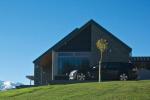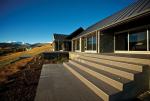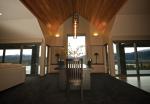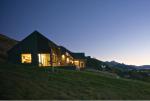Lake Hayes
By Graham Hepburn
As Noel, of Noel Strez Architects, says, “To the forefront of our clients’ brief on this stunning site was the ability for ease of access around and within the house. With a history of mobility issues primarily as a result of sporting injuries and subsequent operations, the desire for a single-storey house or one with ease of access within it was paramount.”
He says that creating an elongated form was a natural response to the site.
“With the magnificent outlook to the northwest across Lake Hayes towards Coronet Peak, a fundamental decision was made early in the design process that all living spaces and five bedrooms should take advantage of this outlook and maximise the afternoon sun,” Noel says. “This approach meant the building platform width for the site allocated in the subdivision plan was marginally exceeded resulting in the need for a Resource Consent application.”
He adds, “To address all of these requirements, the design philosophy for the proposed house form was derived from the early gold miners cottages in the region where small simple rectangular structures with steep pitched roofs dominated the architectural landscape. To maintain this design simplicity the house has a symmetrical appearance to the northwest direction from which the house is predominantly viewed. The house roof form has been broken along its length axis to create a series of small pavilions that help reduce the lineal look. These small roof pavilions are linked by flat roofs while still complying with the 20 per cent maximum flat roof component as required in the consent notice on the land title. All of this creates a scale more sympathetic to the heritage of the surrounding district.”
The home is predominantly clad in a mixture of schist and cedar weatherboards – again to break up the look - with some plastered walls to the rear of the home, particularly on the garage. Electrically operated aluminium louvres flank the main living area, providing shelter to the tiled patio overlooking the lake.
Noel says the living spaces form the central pavilion and are positioned forward of the adjoining bedroom pavilions either side to allow 180-degree views of the lake and mountains. The dining area gable roof has been turned through 90 degrees and is positioned on the central axis to emphasise this symmetry with louvred flat roofs each side controlling sunlight.
To the south of the central pavilion, a bedroom wing to accommodate the family has been created housing three bedrooms with associated service rooms. On its southern side is a separate sauna house that also has lake and mountain views. To the north of the central pavilion, another bedroom wing mirrors the south pavilion and provides two further bedrooms and guest living for use by extended family and friends.
The garage pavilion has been centrally positioned on the eastern side – the rear of the home - maintaining the central axis theme although it is mostly concealed from view by the central living pavilion.
Noel says keeping the rooflines simple and traditional allows the house to sit easily in the landscape.
“To enhance these simple pitched roof forms, COLORSTEEL® Euroline Battenlok roofing was chosen, being a descendant of 18th Century standing seam roofing,” he says. “The ability for it to be produced in long lengths allowed it to be taken continuously up and over the ridge line from eave line to eave line with matching COLORSTEEL® ridge caps provided to each standing seam. This created a shape-crispness to the ridge line eliminating the need for a heavy looking continuous ridge flashing. The Euroline wide profile contrasts well with the texture of the predominance of natural Central Otago schist stone and charcoal stained cedar boarding used on the exterior walls. The Grey Friars COLORSTEEL® chosen conforms to the light reflectance levels required by Council and the wide eaves further enhance this colour palette by creating an abundance of varying shadowing.”
Yellow cedar timber soffit cladding has been used to provide contrast and a sense of lightness. The same timber has also been used in the sauna room.
The builders on the job were Wanaka-based CDL Building, and they have entered the project in this year’s Registered Master Builders’ House of the Year Awards.
Managing director Justin Carnie says the tight-stacked schist veneer cladding system seamlessly flows through from the exterior to the interior.
While the home might have the look of a miner’s cottage, it certainly has a lot more comfort with in slab hydronic underfloor heating system throughout and electric under-tile heating systems to all the bathrooms. There are zoned thermostatic controllers in all areas for the underfloor heating as well as for the ducted air conditioning system throughout the home. To keep the heat in, thermally broken, Low E, argon-filled double glazing with aluminium joinery has been used, along with Pink Batts Ultra R2.8 insulation to exterior wall cavities and Pink Batts Ultra R 5.0 insulation to the roof space.
A Living Flame gas fireplace is a centrepiece of the living area, and has been integrated within a schist, American white oak and granite surround.
A C-Bus home automation set-up controls audio-visual systems, window treatments, heating and cooling, security and lighting (interior and exterior), with the ability to connect to smart phones and tablets. The fit-out of the interior includes granite and marble benchtops and splashbacks to all vanity, cellar, bedroom and kitchen joinery, as well as custom-made timber veneered joinery to bedrooms, bathrooms and kitchens.
Justin Carnie says, “This refined, spacious and extensively detailed home was designed and built purely with the clients’ comfort and lifestyle in mind. To meet the exacting requirements of the design specifications and expectations of the clients, an extremely high level of attention was paid to every detail during each phase of the construction process. The floor area of 660sq m allows for seamless flow throughout the home whilst also highlighting the scale of detailing involved. The blend of the functional and the aesthetically pleasing has created an overall result, which is totally compatible with the owners and the surrounding environment.”





